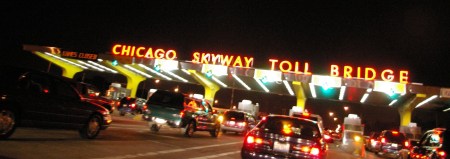
“Follow the money…”
The National Building Museum‘s newest exhibition is open for business – a brief history of parking structures. The exhibit has a great collection of archival photos and other items, looking at the evolution of parking structures through time – from elaborate, full-service garages to self-parking decks to LEED certified garages that attempt to make parking a car sustainable in some fashion. Likewise, the exhibit delves into the social role of the parking structure – with a clip of prominent movie scenes from parking garages (meeting with Deep Throat, getting cool, and getting lost, amongst others) as well as the raw aesthetics of these structures.
What’s missing, however, is any discussion of why parking is necessary.
Philip Kennicott, the Washington Post‘s architecture critic, has a review of the exhibition in this Sunday’s paper. He notes the fact that the need to park is taken at face value, without question:
The Building Museum’s fascinating and comprehensive “House of Cars” exhibition takes parking for granted, and from that assumption tries to cover the subject dispassionately. It proves that parking structures needn’t be ugly, that they were once more routinely beautiful and integrated into the urban fabric, and that even today they can be architecturally daring if real architects are allowed to explore the poetry of the structure.
The interesting juxtaposition, however, was the exhibit that assumes the need for parking opened just as the story of DC USA’s woefully underutilized parking garage was in the news.
Kennicott also notes another missing piece of the discussion – price. Perhaps this shouldn’t be surprising. Given that the exhibit starts from the position that demand is there for parking no matter what, a discussion of supply, demand, and price would be a bit much. The very idea that we might not need that parking after all never crosses the minds of those designing these structures, at least not as they’re presented to a patron walking through the galleries. Kennicott notes the disconnect:
But the future isn’t all bright for the National Parking Association. Away from the exhibition hall, with its free-flowing red wine and mini-burgers, participants gathered to hear lawyer and lobbyist Vincent Petraro describe how he helped keep at bay a New York proposal to institute “congestion pricing” in the gridlocked south end of Manhattan. This new user fee would charge drivers entering the zone from 6 a.m. to 6 p.m. Proponents hope it will clear up the streets, clean up the air and generate revenue. Petraro worries that it will hurt business. He cites London, which instituted a similar plan in 2003.
“Yeah it worked, if you want to create a ghost town,” Petraro says of a city that at last check was anything but a ghost town.
Congestion pricing, says Prof. Donald Shoup of UCLA, could hurt the bottom line for parking lot owners. The power of that bottom line was obvious throughout the Parking Show of Shows, where even bright signs — environmentally sustainable lighting and other improvements to design — were predicated on their cost savings. But Shoup, who studies the economics of parking, is interested in a different, more civic-oriented bottom line. He argues that parking is yet one more element of the basic American infrastructure that hasn’t been subjected to the basic rules of the market. Cities all too often under-price their parking meters, which explains why drivers tie up traffic cruising for a cheap space. And for decades cities have required developers to include parking as part of new construction, which hides the real cost — economic and environmental — of parking.
Perhaps there was a more literal message to draw from the Bob Woodward’s meeting with Deep Throat in that parking garage – “follow the money.”
Parking is simply a terminal for auto transportation. All modes of transport have three basic elements – vehicles (airplanes, trains, cars), rights of way (the sky, tracks, roads), and terminals (airports, train stations, parking spaces). Even a narrow focus solely on parking spaces can be misleading, to say nothing about simply writing off all other modes of transport. Transportation, by nature, is multi-modal. The reality of our urban environments is more complex than a pretty parking garage.
Which brings us to Columbia Heights, and yet another parking boondoggle. But this may also be the future of parking: Less is more. Most of the larger discussion of parking, including the dialogue at the National Parking Association and to a somewhat disturbing extent in the National Building Museum exhibition, is predicated on the idea that parking is a necessity. That it can be improved, but not eliminated. Even the act of studying parking as an evolving architectural form all too often seems to legitimize that form. But the emptiness of that lot in Columbia Heights, and the nightmare images on display at the “House of Cars” show, suggest that we may not be nearly as addicted to parking as we once believed.
Indeed. However, despite the exhibit’s conceptual shortcomings, it’s definitely worth a visit. As narrow as the focus may be, it’s still a fascinating subject – and the National Building Museum’s exhibit design, per usual, does not disappoint.


